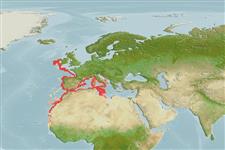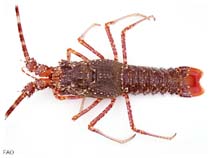Palinurus mauritanicus Gruvel, 1911
Pink spiny lobster| Native range | All suitable habitat | Point map | Year 2050 |

|
| This map was computer-generated and has not yet been reviewed. |
| Palinurus mauritanicus AquaMaps Data sources: GBIF OBIS |
Classification / Names Common names | Synonyms | CoL | ITIS | WoRMS
Malacostraca | Decapoda | Palinuridae
Environment: milieu / climate zone / depth range / distribution range Ecology
Benthic; depth range 180 - 600 m (Ref. 4), usually 200 - 400 m (Ref. 85373). Subtropical, preferred 18°C (Ref. 107945); 55°N - 14°N, 19°W - 17°E (Ref. 4)
Distribution Countries | FAO areas | Ecosystems | Occurrences | Introductions
Eastern Atlantic and the Mediterranean: from west Ireland to southern Senegal and western Mediterranean. Subtropical to temperate.
Length at first maturity / Size / Weight / Age
Maturity: Lm 9.0 range ? - ? cm Max length : 75.0 cm TL male/unsexed; (Ref. 441); common length : 45.0 cm BL male/unsexed; (Ref. 441); max. reported age: 21 years (Ref. 76525)
Maximum body length: 50 cm; a single record of a specimen of 75 cm needs confirmation; usually the body length ranges between 20 and 40 cm (Ref. 4). Lives on rocky and coralligenous substrates near rocky outcrops in edges of the continental shelf (Ref. 85369).
Life cycle and mating behavior Maturity | Reproduction | Spawning | Eggs | Fecundity | Larvae
Reproduces in late summer and fall (Refs. 76522, 76525).
Main reference
References | Coordinator | Collaborators
Goñi, R. and D. Latrouite. 2005. (Ref. 85369)
IUCN Red List Status (Ref. 130435)
Least Concern (LC) ; Date assessed: 03 December 2009
CITES status (Ref. 108899)
Not Evaluated
CMS (Ref. 116361)
Not Evaluated
Threat to humans
Human uses
Fisheries: commercial
FAO - Fisheries: landings | FIRMS (Stock assessments) | FishSource | Sea Around Us
Tools
More information
Internet sources
BHL | BOLD Systems | CISTI | DiscoverLife | FAO(Fisheries: ; publication : search) | Fishipedia | GenBank (genome, nucleotide) | GloBI | Gomexsi | Google Books | Google Scholar | Google | PubMed | Tree of Life | Wikipedia (Go, Search) | Zoological Record
Estimates based on models
Preferred temperature
(Ref. 115969): 10.1 - 14.6, mean 13.2 (based on 89 cells).
Resilience
(Ref. 69278):
Medium, minimum population doubling time 1.4 - 4.4 years (K=0.17-0.18; tmax=21).
Nutrients: Calcium = 109 [35, 184] mg/100g; Iron = 1.59 [1.21, 1.97] mg/100g; Protein = 20.2 [19.2, 21.3] %; Omega3 = 0.285 [0.185, 0.386] g/100g; Selenium = 48.3 [-31.7, 128.3] μg/100g; VitaminA = 0 μg/100g; Zinc = 1.79 [1.17, 2.40] mg/100g (wet weight).



